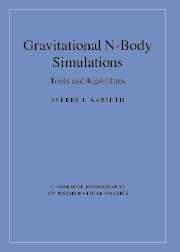Book contents
- Frontmatter
- Contents
- Preface
- 1 The N-body problem
- 2 Predictor–corrector methods
- 3 Neighbour treatments
- 4 Two-body regularization
- 5 Multiple regularization
- 6 Tree codes
- 7 Program organization
- 8 Initial setup
- 9 Decision-making
- 10 Neighbour schemes
- 11 Two-body algorithms
- 12 Chain procedures
- 13 Accuracy and performance
- 14 Practical aspects
- 15 Star clusters
- 16 Galaxies
- 17 Planetary systems
- 18 Small-N experiments
- Appendix A Global regularization algorithms
- Appendix B Chain algorithms
- Appendix C Higher-order systems
- Appendix D Practical algorithms
- Appendix E KS procedures with GRAPE
- Appendix F Alternative simulation method
- Appendix G Table of symbols
- Appendix H Hermite integration method
- References
- Index
16 - Galaxies
Published online by Cambridge University Press: 18 August 2009
- Frontmatter
- Contents
- Preface
- 1 The N-body problem
- 2 Predictor–corrector methods
- 3 Neighbour treatments
- 4 Two-body regularization
- 5 Multiple regularization
- 6 Tree codes
- 7 Program organization
- 8 Initial setup
- 9 Decision-making
- 10 Neighbour schemes
- 11 Two-body algorithms
- 12 Chain procedures
- 13 Accuracy and performance
- 14 Practical aspects
- 15 Star clusters
- 16 Galaxies
- 17 Planetary systems
- 18 Small-N experiments
- Appendix A Global regularization algorithms
- Appendix B Chain algorithms
- Appendix C Higher-order systems
- Appendix D Practical algorithms
- Appendix E KS procedures with GRAPE
- Appendix F Alternative simulation method
- Appendix G Table of symbols
- Appendix H Hermite integration method
- References
- Index
Summary
Introduction
Recent years have seen impressive advances in the simulation of collisionless systems. However, a wide range of problems in galactic dynamics are still amenable to direct N-body integration and will therefore be discussed for completeness. This chapter also serves as a historical review of several topics that blossomed from a primitive beginning. All such problems are characterized by the employment of a small softening of the potential which reduces the effect of close encounters. We begin by describing an application of the grid perturbation method to a ring of interacting molecular clouds in the inner part of the Galaxy [Aarseth, 1988b]. This enables a realistic number of clouds to be considered. The tidal disruption of dwarf spheroidal galaxies orbiting the Milky Way has also been studied by direct means [Oh, Lin & Aarseth, 1995].
More extreme interactions of galaxies often result in the formation of one system, subsequently denoted as a remnant to distinguish this process from mergers used for hierarchical stellar configurations. Studies of galaxy interactions involving black holes have also become topical [Makino & Ebisuzaki, 1996; Makino, 1997]. This problem is particularly challenging because of the difficulty of scaling to realistic conditions. Small galaxy groups and clusters are ideal for N-body simulations if close encounters can be treated using a softened potential.
- Type
- Chapter
- Information
- Gravitational N-Body SimulationsTools and Algorithms, pp. 297 - 306Publisher: Cambridge University PressPrint publication year: 2003



